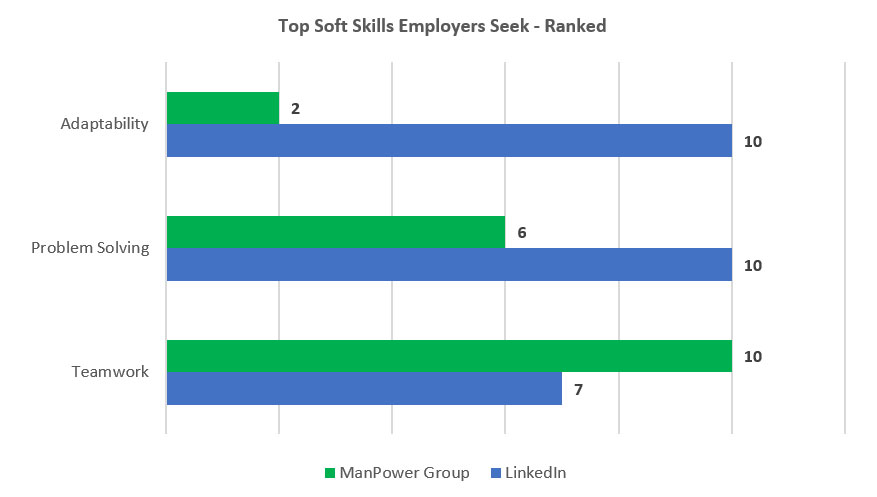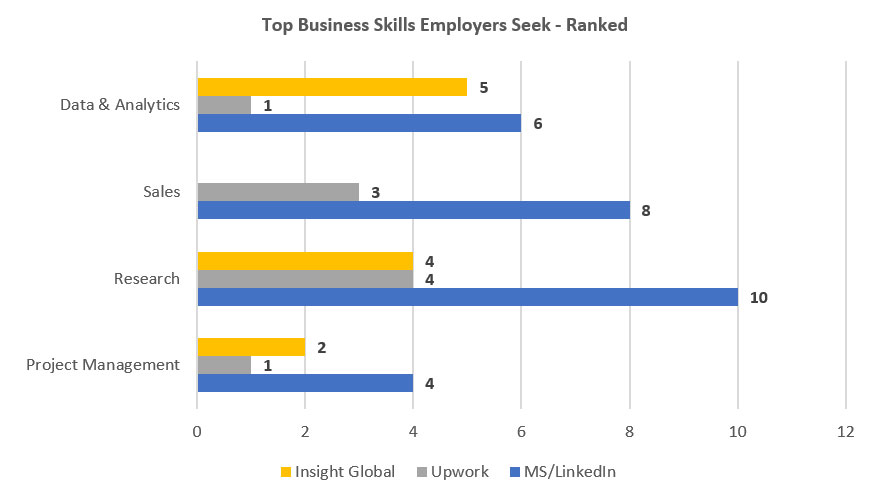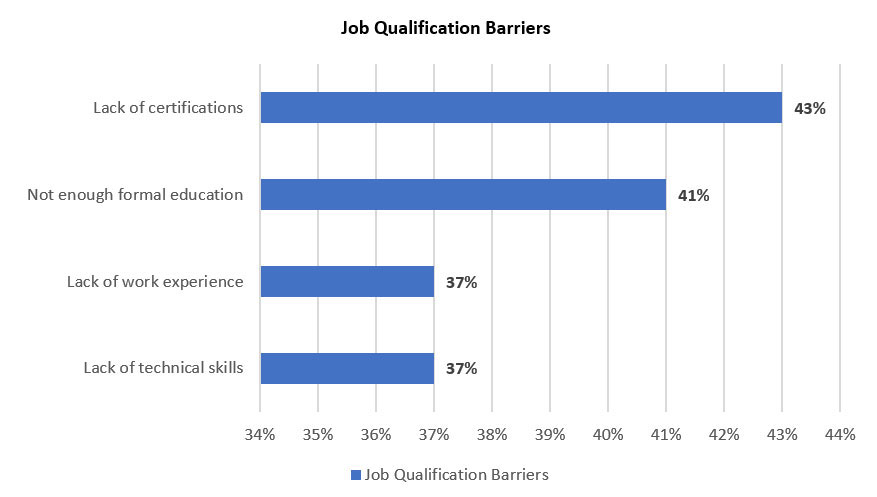Managing Talent Acquisition and Retention During a Labor Shortage

The U.S. labor market is perplexing. Corporate executives are cautiously optimistic about the economy. There were 8.5 million job openings in June 2024.1 The unemployment rate in May was four percent — only slightly higher than the same period last year.2
These statistics seem to suggest the economy is strong, company growth is creating more openings, and workers are finding and remaining employed. Yet, 70% of corporate leaders in the U.S. say they are unable to fill open positions.3
The numbers aren’t adding up. Why? And, more important, what can companies do to ensure their recruitment and retention strategies are successful?
Which industries are most affected by the labor shortage?
Almost every vertical in the U.S. labor market is affected by worker shortages. However, some are at higher risk than others. According to the U.S. Chamber of Commerce, food services and hospitality have the highest quit rates, though hospitality has maintained the highest hiring rate for years.4 Food services and hospitality aren’t alone in the struggle to maintain employees. Manufacturing, retail, and even professional and financial services are also high on the Chamber of Commerce’s list.

Recruiters are reporting similar talent acquisition trends. ManpowerGroup cites global talent shortages above 70% in eight professional industries.5 The deepest impact (77%) is in Health Care and Life Sciences. While unsettling, this statistic isn’t surprising as physicians, nursing and other healthcare positions steadily declined over the last 20 years. Shortages cited in other industries include:
- Consumer Goods and Services (76%)
- Information Technology (76%)
- Transport, Logistics and Automotive (76%)
- Industrials and Materials (75%)
- Communication Services (73%)
- Financials and Real Estate (72%)
- Energy and Utilities (71%)
Researchers may not agree on which industries are experiencing the worst labor shortages. However, one thing is clear: There are more open positions than candidates to fill them.
When examining the labor shortage, population shifts can’t be ignored. Baby Boomers, the second largest population cohort, are exiting the job market. In the next six years, 75 million will be retired.6 While Generation X and Millennials account for 53 and 56 million workers, respectively, a skills gap will remain when Generation X begins to retire.
Employee churn is also deepening the shortage. A survey of employees revealed almost 50% are planning to quit their jobs within the next year. Of U.S. workers polled, 85% are considering looking for new roles this year.7
No matter the industry, employers, job candidates and employees aren’t completely aligned on recruitment and retention goals and needs.
Misaligned expectations are intensifying the labor shortage.
A successful hire is contingent on the employer’s and candidate’s ability to agree on mutual objectives. Job responsibilities, opportunity for growth, income and benefits are key considerations for both parties. However, three underlying dynamics ― mismatched skills, workers’ financial needs and shifting priorities ― are stoking discord in both hiring and retention.
-
Employers think candidates lack important skills.
Forty-eight percent of employers say they are experiencing difficulties finding candidates with skills appropriate to the roles they want to fill.8 Soft skills are high on the list of must-haves. For example, both LinkedIn and ManPower Group employer surveys ranked adaptability, problem solving and teamwork among top in-demand soft skills they’d like candidates to have – though degrees of importance varied. LinkedIn cited adaptability as the “top skill of the moment,” and ManPower Group ranked it fifth in its top five.

Sources: LinkedIn, “The Most In-Demand Skills for 2024,” February 8, 2024; ManPower Group, “2024 Global Talent Shortage,” Q4 2023
LinkedIn respondents cited communication as the number one desired skill, while collaboration/teamwork was most important to ManPower Group’s participants. Staffing agency Insight Global also ranked communication as the number one desired skill and is among many companies that believe it is a critical soft skill.9
Hard skills aren’t as readily transferable across industries. However, four technical skills are consistently among top hiring criteria for many corporations. They include data and analytics, project management, sales and research.

Source: Insight Global, “Insight Global, “11 In-Demand Skills for 2024,” February 28, 2023; Microsoft/LinkedIn, “2024 Work Trend Index Annual Report,” May 8, 2024; Upwork, “Upwork Unveils Most In-Demand Work Skills in 2024,” March 19, 2024
Whether payroll administration, back-office processing or complex reporting, technology is the backbone of corporations. C-suite executives see technology as the number one cause of business change and 61% believe the pace at which it advances will accelerate.10 Technology skills are diverse, continually evolving and always among the top in-demand hard skills in every industry. Organizations are seeking specialists in cybersecurity, machine learning engineering, cloud computing, software development ― to name a few of the many sectors where professionals are needed.
Generative artificial intelligence (Gen AI) is now among the most highly sought-after technological skills. Eighty-two percent of leaders consider Gen AI critical to advancing their corporations.11 Gen AI features deep learning models capable of automation, generating personalized content, as well as researching, analyzing and reporting technical data. Organizations that successfully adopt Gen AI can achieve upwards of $10.3 trillion in additional economic value, while lowering operational costs.12 -
Job seekers feel new roles are hard to obtain.
Fifty-nine percent of job seekers feel their search isn’t progressing as quickly as they would like.13 Misaligned skills plays a large role in job seekers’ inability to connect with employers.
According to Indeed’s “2024 Workforce Insights Report,” job seekers perceive significant qualification barriers, including lack of adequate education and work experience.

Source: Indeed, “2024 Workforce Insight’s Report”
Ironically, even those who are employed feel out of sync with their employers. Over a third think their qualifications, job histories and titles don’t align with their abilities (which they consider “hidden skills.”)14 -
Workers want higher compensation.
The economy shapes both corporate leaders’ and consumers’ perceptions of the job market. While the economy seems to be turning in a positive direction, 52% of consumers feel financially stressed.15 Of course, this is more pronounced among job seekers who are unemployed. However, even 58% of employed respondents in the Indeed report cited compensation as the top priority when evaluating a new role. -
Job seekers are more selective when choosing employers.
Compensation is a top consideration for job seekers, but it isn’t the only factor when deciding where to work. For example, some employees who switched jobs to earn more during the pandemic are regretting their decisions for reasons other than compensation.
Work/life balance, career growth and job security are among the critical factors job seekers evaluate before accepting a new role. Another important criteria is corporate culture. Forty-six percent of job seekers say company culture is important.16
Close skills, hiring and retention gaps.
A recent SHRM survey indicates that 75% of employers are struggling to fill open positions and 49% aren’t retaining full-time employees over a 12-month period.17 In addition to misaligned skills and compensation, respondents cited low numbers of applicants (60%), competition from other employers (55%) and candidate ghosting (46%) among recruitment challenges. Personal reasons (54%), limited advancement opportunities (49%) and poor leadership (50%) were among top reasons for employee attrition, along with compensation. Closing skills and compensation gaps, and other needs will help in developing an effective talent acquisition strategy.
-
Offer fair compensation and benefits.
To attract high-quality candidates and mitigate employee churn, employer salaries should be commensurate with skills and experience. Job seekers are also asking that companies disclose salaries in job postings or early in the interview process so both parties can determine if the roles match expectations. Retirement, wealth and financial planning, and deferred compensation are also attractive benefits as more employees and top earners prepare for their financial futures. -
Implement skills-based hiring and specialized training.
Companies are using an increasingly popular recruitment method that weighs competency more heavily than education and experience. Skills-based hiring evaluates how well candidates meet the capabilities needed for the roles. For example, a potential employee with strong data and analytic skills would be considered even without a computer or information technology degree. Pre-employment assessments help to identify whether a candidate’s skills match those needed for a specific role. Skills-based hiring also accelerates the hiring process — effectively addressing another job seeker complaint.
To increase employee engagement, companies now offer training tailored to skills and employee interests as part of learning and development. Encouraging an “always-learning” work environment not only addresses skills gaps, but also reflects an employer’s willingness to invest in employees. -
Help employees balance busy schedules.
A stressed employee won’t be a productive one. Access to comprehensive, affordable health insurance within early days of employment is standard at most companies. Wellness and mental health programs are also effective in helping employees manage work and life challenges and companies offer them as well.
“Flexibility” is highly desirable among job seekers, 78% of whom said it would save them time and money in a Robert Half survey.18 The pandemic required remote work but, since restrictions eased, most surveys report employees prefer hybrid arrangements. Companies are also exploring four-day workweeks and flexible hours to give employees more options for how they work. -
Make employees feel welcome and appreciated.
Seventy-seven percent of job seekers research companies’ cultures before applying for work.19 Popular recruitment sites and job boards feature employee workplace reviews, including salaries, leadership and diversity, as well as interview tips. This information helps potential candidates assess whether a company’s values match their own. Seek regular employee feedback to ensure your company is offering a welcoming environment where employees feel appreciated and believe they can succeed.
Attract and retain talent in a competitive market.
Competition for talented employees is stiff. However, companies with talent acquisition strategies that include a positive work culture (59%), competitive benefits (59%) and salary (54%) and flexible work arrangements (53%) are winning the battle.20
Synovus can help your organization stay informed of employee preferences and trends, as well as develop compensation and benefits packages that are attractive to high-quality candidates.
Operations
How to Ensure Resilient Financial Operations During Crises
Operations
Business Resilience Guide: Effective Continuity Planning to Mitigate Disruptions
Operations
Unlocking Revenue Growth with Data-Driven Decision-making
-
Will Your Organization Make the Fraud 'Naughty or Nice' List?
Protect your business from holiday fraud. Learn key stats, prevention tips, and how to recognize phishing, spoofing, and account takeover scams in 2024.
-
Interest Rates News: Fourth Quarter 2025
Get the latest Q4 2025 FOMC rate updates, forecasts and borrowing tips. Learn how interest rate changes impact loans, mortgages, and business growth.
Important disclosure information
This content is general in nature and does not constitute legal, tax, accounting, financial or investment advice. You are encouraged to consult with competent legal, tax, accounting, financial or investment professionals based on your specific circumstances. We do not make any warranties as to accuracy or completeness of this information, do not endorse any third-party companies, products, or services described here, and take no liability for your use of this information.
- U.S. Chamber of Commerce, “Understanding America’s Labor Shortage: The Most Impacted Industries,” June 24, 2024 Back
- Bureau of Labor Statistics, “The Employment Situation – May 2024,” June 7, 2024 Back
- Manpower, “2024 Global Talent Shortage,” 2024 Back
- U.S. Chamber of Commerce, “Understanding America’s Labor Shortage: The Most Impacted Industries,” June 24, 2024 Back
- Manpower, “2024 Global Talent Shortage,” 2024 Back
- Worldwide ERC, “Baby Boomers are Retiring: Implications for the Workforce and Economy,” August 14, 2023 Back
- Mercer, “Workforce 2.0: Unlocking Human Potential in a Machine-Augmented World, Mercer Global Talent Trends 2024” Back
- Microsoft/LinkedIn, “2024 Work Trend Index Annual Report,” May 8, 2024 Back
- Insight Global, “Insight Global, “11 In-Demand Skills for 2024,” February 28, 2023 Back
- Accenture, “2024 Pulse of Change Index” Back
- Korn Ferry, “Talent Acquisition Trends Report 2024” Back
- Accenture, “Reinvention in an Era of Permacrisis,” April 27, 2024 Back
- AeroTek, “Job Seeker Survey: Searching for Stability & Better Pay,” June 18, 2024 Back
- PwC, “Global Workforce Hopes and Fears Survey,” June 24, 2024 Back
- Ibid Back
- Zippia, “25+ Essential Company Culture Statistics [2023]: Why is Company Culture Important,” August 31, 2023 Back
- SHRM, “2024 Talent Trends” Back
- Robert Half, “Remote Work Statistics and Trends for 2024,” June 5, 2024 Back
- Zippia, “25+ Essential Company Culture Statistics [2023]: Why is Company Culture Important,” August 31, 2023 Back
- SHRM, “2024 Talent Trends” Back
